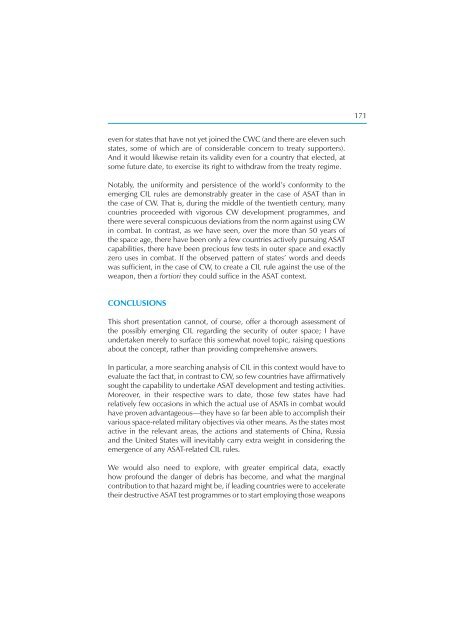Security in Space The Next Generation - UNIDIR
Security in Space The Next Generation - UNIDIR
Security in Space The Next Generation - UNIDIR
You also want an ePaper? Increase the reach of your titles
YUMPU automatically turns print PDFs into web optimized ePapers that Google loves.
even for states that have not yet jo<strong>in</strong>ed the CWC (and there are eleven such<br />
states, some of which are of considerable concern to treaty supporters).<br />
And it would likewise reta<strong>in</strong> its validity even for a country that elected, at<br />
some future date, to exercise its right to withdraw from the treaty regime.<br />
Notably, the uniformity and persistence of the world’s conformity to the<br />
emerg<strong>in</strong>g CIL rules are demonstrably greater <strong>in</strong> the case of ASAT than <strong>in</strong><br />
the case of CW. That is, dur<strong>in</strong>g the middle of the twentieth century, many<br />
countries proceeded with vigorous CW development programmes, and<br />
there were several conspicuous deviations from the norm aga<strong>in</strong>st us<strong>in</strong>g CW<br />
<strong>in</strong> combat. In contrast, as we have seen, over the more than 50 years of<br />
the space age, there have been only a few countries actively pursu<strong>in</strong>g ASAT<br />
capabilities, there have been precious few tests <strong>in</strong> outer space and exactly<br />
zero uses <strong>in</strong> combat. If the observed pattern of states’ words and deeds<br />
was suffi cient, <strong>in</strong> the case of CW, to create a CIL rule aga<strong>in</strong>st the use of the<br />
weapon, then a fortiori they could suffi ce <strong>in</strong> the ASAT context.<br />
CONCLUSIONS<br />
This short presentation cannot, of course, offer a thorough assessment of<br />
the possibly emerg<strong>in</strong>g CIL regard<strong>in</strong>g the security of outer space; I have<br />
undertaken merely to surface this somewhat novel topic, rais<strong>in</strong>g questions<br />
about the concept, rather than provid<strong>in</strong>g comprehensive answers.<br />
In particular, a more search<strong>in</strong>g analysis of CIL <strong>in</strong> this context would have to<br />
evaluate the fact that, <strong>in</strong> contrast to CW, so few countries have affi rmatively<br />
sought the capability to undertake ASAT development and test<strong>in</strong>g activities.<br />
Moreover, <strong>in</strong> their respective wars to date, those few states have had<br />
relatively few occasions <strong>in</strong> which the actual use of ASATs <strong>in</strong> combat would<br />
have proven advantageous—they have so far been able to accomplish their<br />
various space-related military objectives via other means. As the states most<br />
active <strong>in</strong> the relevant areas, the actions and statements of Ch<strong>in</strong>a, Russia<br />
and the United States will <strong>in</strong>evitably carry extra weight <strong>in</strong> consider<strong>in</strong>g the<br />
emergence of any ASAT-related CIL rules.<br />
We would also need to explore, with greater empirical data, exactly<br />
how profound the danger of debris has become, and what the marg<strong>in</strong>al<br />
contribution to that hazard might be, if lead<strong>in</strong>g countries were to accelerate<br />
their destructive ASAT test programmes or to start employ<strong>in</strong>g those weapons<br />
171








